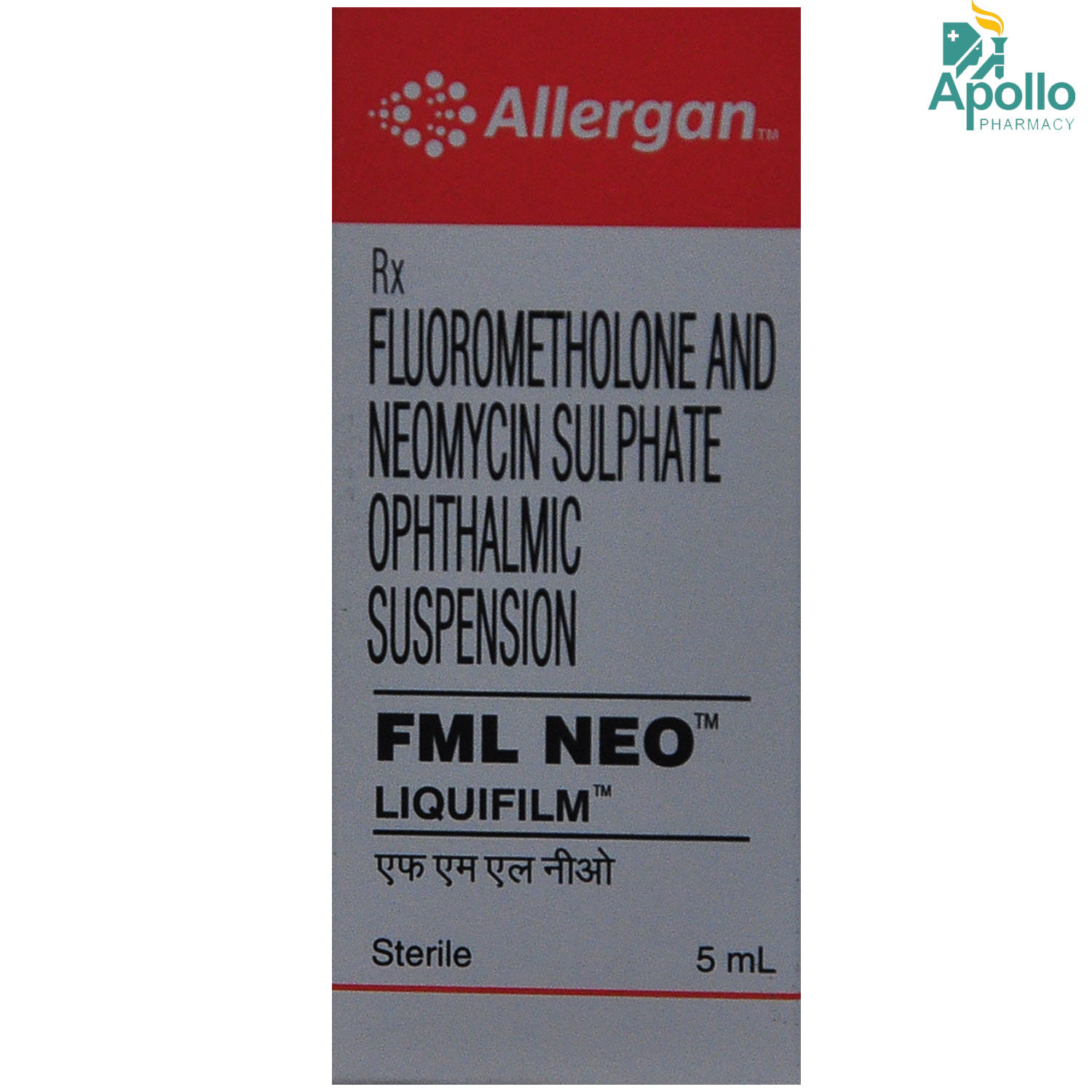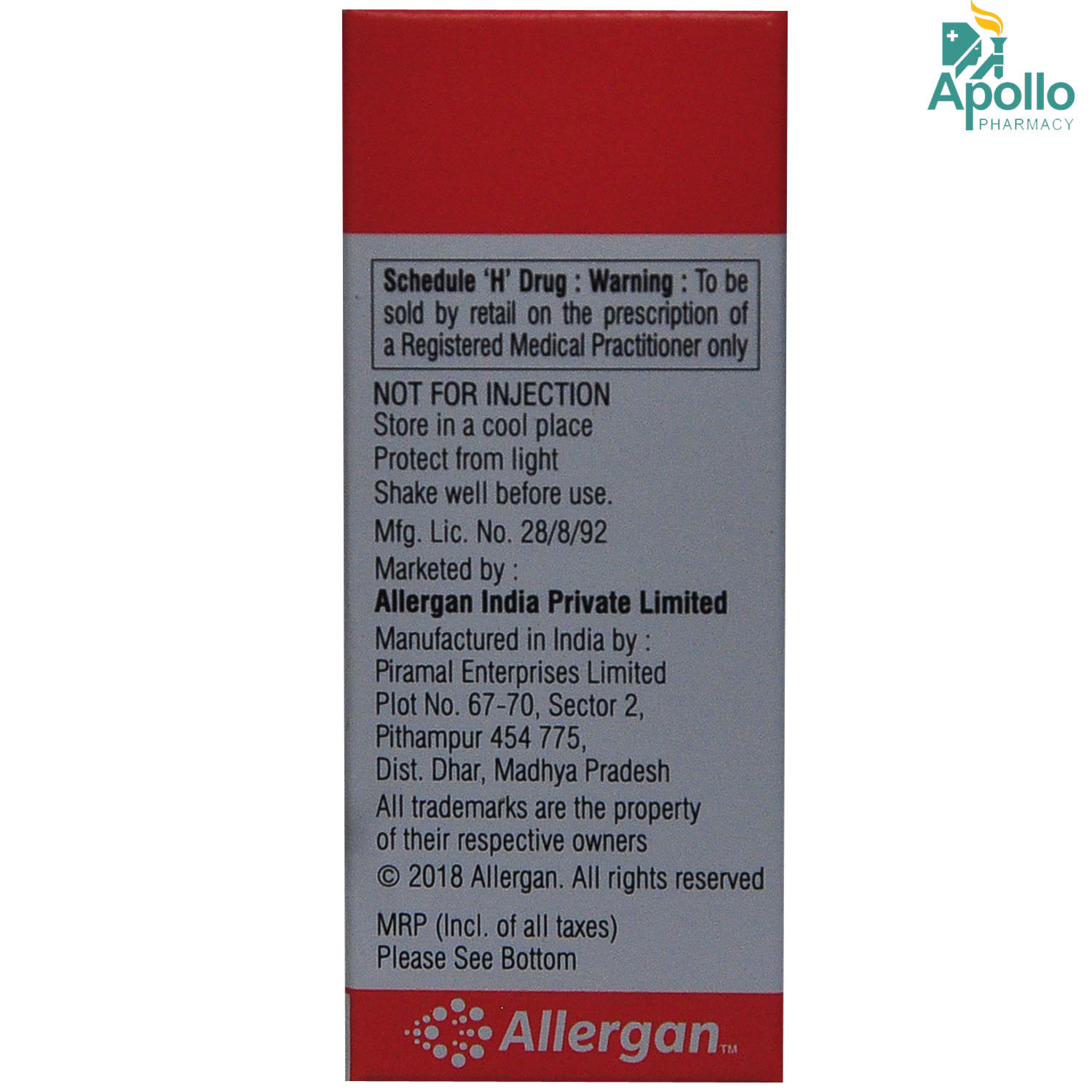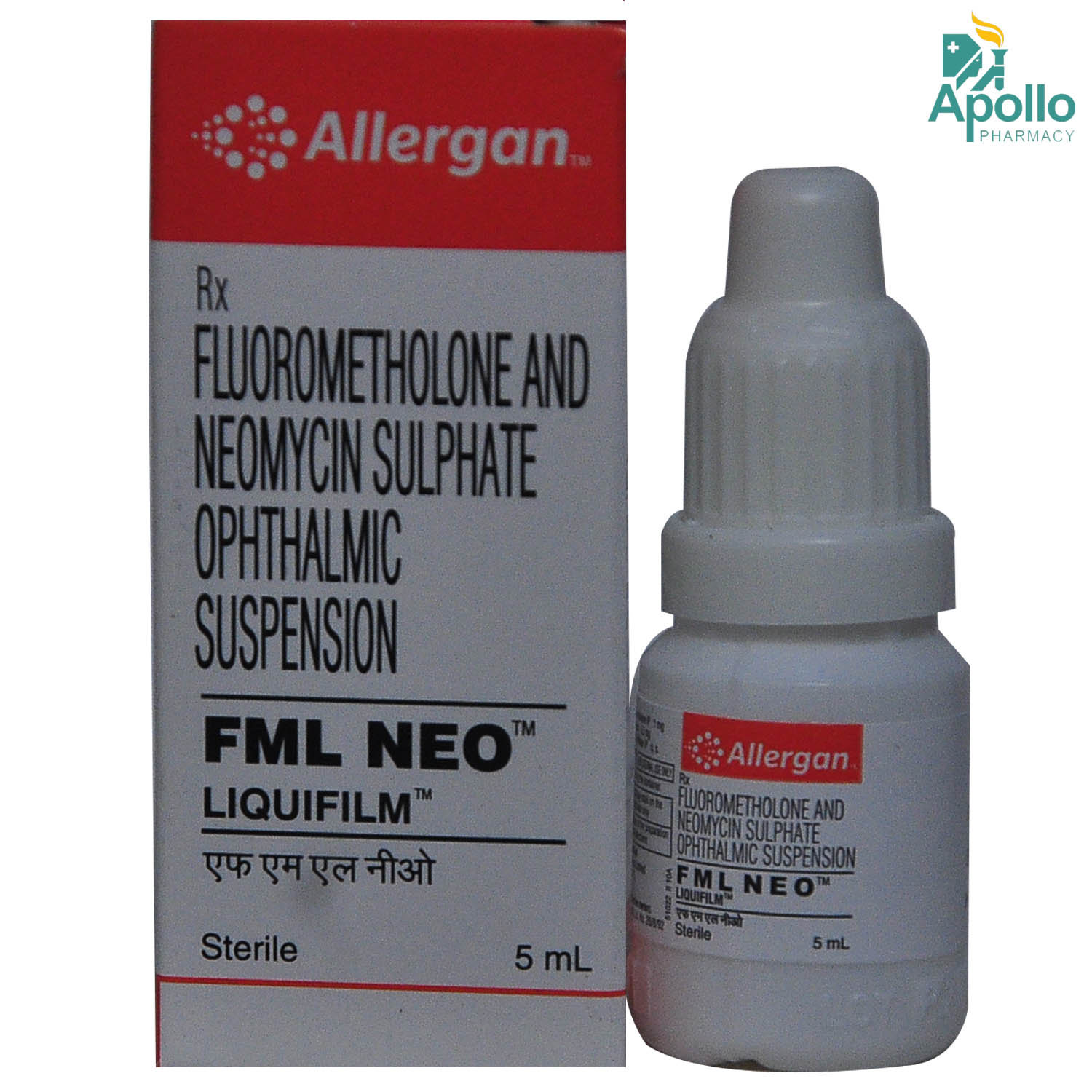FML NEO Liquifilm Eye Drops 5 ml



MRP ₹145.5
(Inclusive of all Taxes)
₹21.8 Cashback (15%)
know your delivery time
Provide Delivery Location
Composition :
Manufacturer/Marketer :
Consume Type :
Expires on or after :
Return Policy :

Secure Payment

Trusted by 8 Crore Indians

Genuine Products
Therapeutic Class
Country of origin
Manufacturer/Marketer address
Disclaimer
Alcohol
Safe if prescribed
Do not take alcohol while using FML NEO Liquifilm Eye Drops 5 ml as it may affect your ability to fight infections.
Pregnancy
Consult your doctor
FML NEO Liquifilm Eye Drops 5 ml should not be used in pregnant females, unless until prescribed by a doctor.
Breast Feeding
Consult your doctor
FML NEO Liquifilm Eye Drops 5 ml should not be used in breastfeeding women, unless until prescribed by a doctor.
Driving
Safe if prescribed
FML NEO Liquifilm Eye Drops 5 ml may cause vision problems. So, avoid driving until your vision clears.
Liver
Consult your doctor
FML NEO Liquifilm Eye Drops 5 ml can be used for treating eye infections in patients with liver diseases.
Kidney
Consult your doctor
FML NEO Liquifilm Eye Drops 5 ml can be used for treating eye infections in patients with kidney diseases.
Children
Safe if prescribed
FML NEO Liquifilm Eye Drops 5 ml is not approved to be use in children below two years and only when prescribed by a doctor.
About FML NEO Liquifilm Eye Drops 5 ml
FML NEO Liquifilm Eye Drops 5 ml belongs to a group of medications called ‘Antibiotics and Corticosteroids’ used in the treatment of bacterial eye infections or eye discomfort, especially in patients who have undergone eye surgeries. It also decreases the risk of eye infections such as conjunctivitis (inflammation of the conjunctiva, pinkeye), and other inflammatory conditions of the eye (cornea, iris and connective tissue) in postoperative patients.
FML NEO Liquifilm Eye Drops 5 ml is a combination of two medicines: Fluorometholone and Neomycin. Neomycin is an aminoglycoside antibiotic that acts by interfering with the formation of essential proteins required for bacterial growth that in turn kills the bacteria by preventing its growth. Fluorometholone is a glucocorticoid that reduces inflammation and symptoms associated with infection such as redness and irritation. It works by inhibiting the chemicals such as prostaglandins that cause inflammation.
FML NEO Liquifilm Eye Drops 5 ml is for ophthalmic (for eye) use only. You should use this medicine as prescribed by your doctor. The common side-effects of FML NEO Liquifilm Eye Drops 5 ml are red eyes, eye pain, irritation of the eye, blurred vision and burning sensation in the eye. Most of these side effects do not require medical attention and will resolve gradually over time. However, you are advised to talk to your doctor if you experience these undesirable effects persistently.
Do not use FML NEO Liquifilm Eye Drops 5 ml if you are allergic to FML NEO Liquifilm Eye Drops 5 ml or any contents of it. Before using FML NEO Liquifilm Eye Drops 5 ml, inform your doctor if you are diagnosed with any fungal infections, viral infections, such as herpes simplex or varicella or parasitic infections such as amoebiasis. Do not use FML NEO Liquifilm Eye Drops 5 ml if you have tuberculosis, damaged cornea, ulceration, open lesions with incomplete formation of the covering tissue and increased pressure inside the eye. FML NEO Liquifilm Eye Drops 5 ml should be used in pregnant, breastfeeding, females if suggested by the doctor. FML NEO Liquifilm Eye Drops 5 ml is not approved to be used in children below two years. This medicine is completely safe and effective in elderly patients, however, they should use FML NEO Liquifilm Eye Drops 5 ml only after consulting with the doctor.
Uses of FML NEO Liquifilm Eye Drops 5 ml
Medicinal Benefits Mweb
Key Benefits
Neomycin present in FML NEO Liquifilm Eye Drops 5 ml is used to treat bacterial infections like conjunctivitis (pinkeye) and blepharitis (inflammation of the oil glands in eyelids) of the eye and the skin present around the eyelids. This medicine is also helpful in preventing the infection that may happen after surgery or eye injury. This medicine works by stopping the growth of bacterial. FML NEO Liquifilm Eye Drops 5 ml also contains fluorometholone, which is a Glucocorticosteroids, has an anti-inflammatory corticosteroid that acts by reducing swelling, itching and redness of the eye and thus helps in treating inflammation of the eye. Fluorometholone is supposed to control the formation of certain chemicals that cause allergic reactions in the body.
Directions for Use
Side Effects of FML NEO Liquifilm Eye Drops 5 ml
- Red eyes
- Eye pain
- Blurred vision
- Dry eye
- Excessive watery eyes
- Change in taste
- Inflammation of the cornea of the eye (severe)
Drug Warnings
FML NEO Liquifilm Eye Drops 5 ml should not be used in certain conditions like ocular tuberculosis, glaucoma, a fungal disease of eyes, pregnancy and breastfeeding females. Eye drops compromising corticosteroids like FML NEO Liquifilm Eye Drops 5 ml should not be used for more than a week except if specially prescribed by a doctor followed by regular checkups for intraocular pressure. Prolong use of FML NEO Liquifilm Eye Drops 5 ml may also suppress the immune response and increase the chances of secondary eye infections. FML NEO Liquifilm Eye Drops 5 ml may affect your ability to drive and operating a machine. If it happens, you are suggested to wait until your vision clears before doing any task that needs a clear vision.
Drug-Drug Interactions
Drug-Drug Interactions
Login/Sign Up
Co-administration of FML NEO Liquifilm Eye Drops 5 ml with torasemide can increase the risk of toxicity.
How to manage the interaction:
Although taking FML NEO Liquifilm Eye Drops 5 ml and torasemide together can possibly result in an interaction, it can be taken if your doctor has advised it. However, if you experience symptoms such as hearing loss, ringing in the ears, vertigo, and kidney problems, consult a doctor immediately. Do not discontinue any medications without consulting a doctor.
Deferasirox may cause kidney problems and combining it with FML NEO Liquifilm Eye Drops 5 ml may increase that risk.
How to manage the interaction:
Although taking FML NEO Liquifilm Eye Drops 5 ml and Deferasirox together can possibly result in an interaction, it can be taken if your doctor has prescribed it. However, if you experience nausea, vomiting, loss of appetite, increased or decreased urination, fluid retention, swelling, shortness of breath, bone pain, muscle cramps, tiredness, weakness, dizziness, confusion, or irregular heart rhythm, seek immediate medical attention. Drink plenty of water if you experience diarrhoea or vomiting while taking these medications, as dehydration can potentially affect the kidneys. Do not discontinue any medications without a doctor's advice.
Taking Magnesium sulfate with FML NEO Liquifilm Eye Drops 5 ml can increase the risk of muscle weakness.
How to manage the interaction:
Although taking Magnesium sulfate and FML NEO Liquifilm Eye Drops 5 ml together can evidently cause an interaction, it can be taken if your doctor has suggested it. However, if you experience symptoms such as muscle weakness and breathing difficulties consult doctor immediately. Do not stop using any medications without a doctor's advice.
Everolimus can cause kidney issues, and taking it with FML NEO Liquifilm Eye Drops 5 ml, can enhance the risk.
How to manage the interaction:
Although taking Everolimus and FML NEO Liquifilm Eye Drops 5 ml together can cause an interaction, it can be taken if a doctor has suggested it. However, if you experience nausea, vomiting, loss of appetite, increased or decreased urination, sudden weight gain or loss, fluid retention, swelling, shortness of breath, muscle cramps, tiredness, weakness, dizziness, confusion, or an irregular heart rhythm, consult a doctor. Do not stop using any medications without talking to a doctor.
Taking Human immunoglobulin with FML NEO Liquifilm Eye Drops 5 ml, may raise the risk of kidney problems.
How to manage the interaction:
Taking Human immunoglobulin with FML NEO Liquifilm Eye Drops 5 ml together can result in an interaction, but it can be taken if a doctor has advised it. However, if you experience nausea, vomiting, loss of appetite, increased or decreased urination, sudden weight gain or loss, fluid retention, swelling, shortness of breath, muscle cramps, tiredness, weakness, dizziness, confusion, or an irregular heart rhythm, consult a doctor. Do not discontinue any medications without consulting a doctor.
Taking tacrolimus with FML NEO Liquifilm Eye Drops 5 ml may increase risk of kidney problems.
How to manage the interaction:
Although taking tacrolimus and FML NEO Liquifilm Eye Drops 5 ml together can possibly result in an interaction, it can be taken if your doctor has prescribed it. However, consult the doctor immediately if you experience symptoms such as nausea, vomiting, loss of hunger, increased or decreased urination, sudden weight gain or weight loss, fluid retention, swelling, shortness of breath, muscle cramps, tiredness, weakness, dizziness, confusion, and irregular heart rhythm. Do not discontinue any medications without consulting a doctor.
Combining Colistin with FML NEO Liquifilm Eye Drops 5 ml can increase the risk or severity of kidney problems.
How to manage the interaction:
Although there is a possible interaction between Colistin and FML NEO Liquifilm Eye Drops 5 ml, you can take these medicines together if prescribed by your doctor. However, if you experience an upset stomach, Rash, Dizziness, or Fever, consult a doctor. Do not stop using any medications without a doctor's advice.
Coadministration of FML NEO Liquifilm Eye Drops 5 ml and Tenofovir disoproxil can increase the risk of developing kidney problems.
How to manage the interaction:
Taking FML NEO Liquifilm Eye Drops 5 ml and Tenofovir Disoproxil together can lead to an interaction, but it can be taken if your doctor advises. However, if you experience any symptoms like vomiting, loss of appetite, increased or decreased urination, sudden weight gain or weight loss, shortness of breath, muscle cramps, dizziness, and irregular heart rhythm, contact your doctor immediately. Do not discontinue any medications without first consulting your doctor.
Coadministration of Botulinum toxin with FML NEO Liquifilm Eye Drops 5 ml may increase the risk of side effects.
How to manage the interaction:
Although there is an interaction between botulinum toxin and FML NEO Liquifilm Eye Drops 5 ml, they can be taken together if prescribed by a doctor. However, contact a doctor immediately if you experience muscle weakness or trouble breathing, swallowing, or speaking. Do not discontinue any medications without consulting a doctor.
When FML NEO Liquifilm Eye Drops 5 ml and Polymyxin B are taken together, there is an increased possibility of severe side effects.
How to manage the interaction:
Taking Polymyxin b with FML NEO Liquifilm Eye Drops 5 ml together can result in an interaction, but it can be taken if a doctor has advised it. However, if you experience nausea, vomiting, a decrease in hunger, increased or decreased urine, weight gain or loss that occurs suddenly, fluid retention, swelling, difficulty breathing, bone pain, muscle pain, fatigue, weakness, dizziness, confusion, and irregular heartbeat, hearing loss, ringing in the ears, vertigo, consult a doctor. Do not discontinue any medications without a doctor's advice.
Drug-Food Interactions
Drug-Food Interactions
Login/Sign Up
Drug-Diseases Interactions
Drug-Diseases Interactions
Login/Sign Up
Drug-Drug Interactions Checker List
- IBUPROFEN
- AMIKACIN
- TOBRAMYCIN
- POLYMYXIN B
- CISPLATIN
- AMPHOTERICIN B
Habit Forming
Special Advise
If you are using other eye drops along with FML NEO Liquifilm Eye Drops 5 ml, maintain an interval of at least 15 minutes before administering other medicines in the same eye to avoid dilution.
Diet & Lifestyle Advise
- Sleep for at least six to eight hours to rejuvenate your eyes in a natural way.
- Wash your eyes with clean water at least two to three times a day.
- Manage stress, eat healthily, drink plenty of water, exercise regularly and get plenty of sleep.
- Avoid alcoholic beverages as it can make you dehydrated and affect your sleep. This effect can also affect your body’s ability in fighting off infections.
- Reduce screen time (by avoiding watching tv, or phone) and use sunglasses while going out into the sunlight.

Have a query?
Buy best Ocular products by
Entod Pharmaceuticals Ltd
Ajanta Pharma Ltd
Sunways (India) Pvt Ltd
Sun Pharmaceutical Industries Ltd
Cipla Ltd
Micro Labs Ltd
Allergan Healthcare India Pvt Ltd
Intas Pharmaceuticals Ltd
Raymed Pharmaceuticals Ltd
Nri Vision Care India Ltd
FDC Ltd
Jawa Pharmaceuticals India Pvt Ltd
Indoco Remedies Ltd
Sapient Laboratories Pvt Ltd
Senses Pharmaceuticals Pvt Ltd
Centaur Pharmaceuticals Pvt Ltd
Neomedix Healthcare India Pvt Ltd
Aromed Pharmaceuticals
Optho Remedies Pvt Ltd
Aurolab
Austrak Pvt Ltd
Lupin Ltd
Mankind Pharma Pvt Ltd
Zivira Labs Pvt Ltd
Optho Pharma Pvt Ltd
Synovia Life Sciences Pvt Ltd
Akumentis Healthcare Ltd
Eyekare
His Eyeness Ophthalmics Pvt Ltd
Protech Remedies Pvt Ltd
Runyon Pharmaceutical Pvt Ltd
Alcon Laboratories Inc
Syntho Pharmaceuticals Pvt Ltd
Alembic Pharmaceuticals Ltd
Bell Pharma Pvt Ltd
Klar Sehen Pvt Ltd
Sentiss Pharma Pvt Ltd
Irx Pharmaceuticals Pvt Ltd
Optho Life Sciences Pvt Ltd
Phoenix Remedies Pvt Ltd
Alkem Laboratories Ltd
Doctor Wonder Pvt Ltd
Hicare Pharma
Ipca Laboratories Ltd
Neon Laboratories Ltd
Okulus Drugs India
Pharmtak Ophthalmics (I) Pvt Ltd
Berry & Herbs Pharma Pvt Ltd
Glow Vision Pharmaceuticals
Kaizen Drugs Pvt Ltd
Choroid Laboratories Pvt Ltd
Indiana Opthalamics Pvt Ltd
Optica Pharmaceutical Pvt Ltd
Pharmatak Opthalmics India Pvt Ltd
Samarth Life Sciences Pvt Ltd
Vibgyor Vision Care
Mofon Drugs
Novartis India Ltd
Pharmia Biogenesis Pvt Ltd
Zydus Cadila
Appasamy Ocular Devices Pvt Ltd
Leeford Healthcare Ltd
Medivision Pharma Pvt Ltd
Orbit Life Science Pvt Ltd
X-Med Royal Pharma Pvt Ltd
Zee Laboratories Ltd
Aarma Laboratories
Guerison MS Inc
Laborate Pharmaceuticals India Ltd
Xtas Pharmaceuticals
Accurex Biomedical Pvt Ltd
Blucrab Pharma Pvt Ltd
Does Health Systems Pvt Ltd
Flagship Biotech International Pvt Ltd
Lavue Pharmaceuticals Pvt Ltd
Nutrilis Healthcare Pvt Ltd
Ursa Pharm India Pvt Ltd
Vee Remedies
Vyonics Health Care India Pvt Ltd
Warren Pharmaceuticals Pvt Ltd
Abbott India Ltd
Accvus Pharmaceuticals
Akums Drugs & Pharmaceuticals Ltd
Cadila Healthcare Ltd
Carevision Pharmaceuticals Pvt Ltd
Dey's Medical Stores (Mfg) Ltd
East West Pharma India Pvt Ltd
Eyedea Pharmaceuticals Pvt Ltd
Nimbus Healthcare Pvt Ltd
Ocuris Pharmaceuticals Pvt Ltd
Sherings Pharmaceuticals
Tarks Pharmaceuticals Pvt Ltd
Vcan Biotech
Vision Medilink
Aice Health Care Pvt Ltd
Appasamy Pharmaceuticals Pvt Ltd
Asperia Lifescience Pvt Ltd
Beatum Healthcare Pvt Ltd
East India Pharmaceutical Works Ltd
Grevis Pharmaceutical Pvt Ltd

